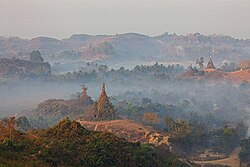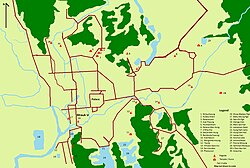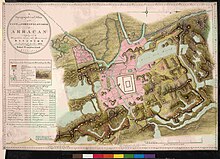Mrauk U
Mrauk U
မြောက်ဦးမြို့ | |
|---|---|
Town | |
 Mrauk U from Shwetaung pagoda | |
 Map of Mrauk U with main temples | |
| Coordinates: 20°35′24″N 93°11′33″E / 20.59000°N 93.19250°E | |
| Country | Myanmar |
| Division | Rakhine State |
| District | Mrauk-U District |
| Township | Mrauk-U Township |
| Settled | 16 November 1430 |
| Population | 36,139[1] |
| • Ethnicities | Rakhine and other tribals |
| • Religions | Mainly Theravada Buddhism with minority Islam and minority Catholic |
| Time zone | UTC+6.30 (MMT) |
Mrauk U[a] (/məˈraʊuː, ˈmraʊuː/ mə-ROW-oo, MROW-oo) is a town in northern Rakhine State, Myanmar. It is the capital of Mrauk-U Township, a subregion of the Mrauk-U District.
Mrauk U is culturally significant for the local Rakhine (Arakanese) people and is the location of many important archeological sites. From 1430 until 1785, it was the capital of the Mrauk U Kingdom, the largest and most powerful Rakhine kingdom in history.
Geography
[edit]Mrauk U lies roughly 11 kilometres (6.8 mi) east of the Kaladan River on the banks of its minor tributaries. The town is located on a small outcrop of the Rakhine Yoma on the eastern side of the Kaladan's alluvial plain. Thus, the surrounding countryside is hilly yet also contains a great deal of marshes, mangroves and lakes.
Climate
[edit]Mrauk U, like all of Rakhine State, is situated in a coastal tropical monsoon rainforest climate (Köppen Am) region. The town receives over 3,600 millimetres or 140 inches of rain a year from the Southwestern Monsoon, making it one of the wettest regions in Myanmar.[2] The Monsoon season usually begins in late May and ends by mid October.[3]
Although located in a tropical region, Mrauk U enjoys lower temperatures during the arid Northeastern Monsoon. From mid October to mid March during the Cool Season, temperatures can drop to 13 °C or 55.4 °F.[4] This season coincides with the tourist season for Myanmar.
The rainfall on 19 July 2011 was nearly 24 cm (9.4 in), the highest for 33 years. There was flood because of continuous heavy rains in July 2011.[5]
| Climate data for Mrauk U (1981-2010) | |||||||||||||
|---|---|---|---|---|---|---|---|---|---|---|---|---|---|
| Month | Jan | Feb | Mar | Apr | May | Jun | Jul | Aug | Sep | Oct | Nov | Dec | Year |
| Mean daily maximum °C (°F) | 30.4 (86.7) |
32.7 (90.9) |
35.2 (95.4) |
36.0 (96.8) |
34.7 (94.5) |
31.0 (87.8) |
30.0 (86.0) |
30.4 (86.7) |
31.9 (89.4) |
33.1 (91.6) |
32.1 (89.8) |
30.3 (86.5) |
32.3 (90.1) |
| Mean daily minimum °C (°F) | 12.1 (53.8) |
13.9 (57.0) |
18.3 (64.9) |
22.8 (73.0) |
24.0 (75.2) |
24.2 (75.6) |
23.9 (75.0) |
23.8 (74.8) |
24.2 (75.6) |
23.2 (73.8) |
19.8 (67.6) |
14.9 (58.8) |
20.4 (68.7) |
| Average rainfall mm (inches) | 4.6 (0.18) |
8.1 (0.32) |
14.2 (0.56) |
52.3 (2.06) |
286.1 (11.26) |
876.4 (34.50) |
1,002.5 (39.47) |
788.2 (31.03) |
355.3 (13.99) |
187.1 (7.37) |
57.9 (2.28) |
10.7 (0.42) |
3,643.4 (143.44) |
| Source: Norwegian Meteorological Institute[6] | |||||||||||||
Etymology
[edit]Some Rakhine scholars state that the name Mrauk U means 'The First Accomplishment' in archaic Arakanese. This is based on the story of the Arakanese being able to crush an invasion by the Pyu in the mid 10th Century by a Mro prince, Pai Phru. The town is said to be located roughly near the region where the Pyu invaders were decimated. The prince went on to claim the throne of Waithali from his uncle who had murdered the prince's father due to a love scandal. The battle was seen as the first accomplishment of the prince, and thus, the name 'First Accomplishment' came to be associated with the place.[7]
Mythology
[edit]A dismissed myth was that in the region where Mrauk U was to be constructed, lived a lonely female monkey. She met a peacock and the two later cohabited. The female monkey conceived with the peacock, and it laid an egg. A human son was born from the egg and he grew up to become a mighty prince. The prince later built a city near the jungle, and in respect of his birth story, the city was called Myauk-U meaning "Monkey's Egg".[7]
History
[edit]
In 1430, King Min Saw Mon established Mrauk U as the capital of the last unified Arakanese Kingdom. The city eventually reached a size of 160,000 in the early seventeenth century.[8] Mrauk U served as the capital of the Mrauk U kingdom and its 49 kings till the conquest of the kingdom by the Burmese Konbaung Dynasty in 1784.
Mrauk-U was divided into three periods: the earliest period (1430–1530), the middle period (1531–1638), and the last period (1638–1784). In Arakan antiquities at the Mrauk-U seems to give rational evidence as to where Buddhism was settled down. The golden days of Mrauk U city, those of 16th and 17th centuries were contemporary to the days of Tudor kings, the Moghuls, the Ayutthaya kings and Ava (Inwa), Taungoo and Hanthawaddy kings of Myanmar. Mrauk U was cosmopolitan city, fortified by a 30-kilometer long fortification and an intricate net of moats and canals. At the centre of the city was the Royal Place, looming high over the surrounding area like an Asian Acropolis. Waterways formed by canals and creeks earned the fame of distinct resemblance to Venice.
Mrauk U offers some of the richest archaeological sites in Southeast Asia. These include stone inscriptions, Buddha images, the Buddha's footprints and the great pagoda itself which, stripped its later-constructed top, would be of the same design as the Gupta style of ancient India. In the city of golden Mrauk-U there are scattering innumerable temples and pagodas which preserved as places, thereby exerting a great influence on spiritual life of the people.[citation needed]

During British colonial rule, Mrauk U was known as "Mrohaung" or "Myohaung".[citation needed] The area was the site of fighting during the Arakan Campaign, in the latter part of the Second World War.
On 16 January 2018, Rakhine protesters rioted near a government building in Mrauk U after a ban was issued by local authorities on an event that commemorated the anniversary of the Kingdom of Mrauk U's dissolution.[9][10] In response to protesters attempting to seize the government building, police fired live ammunition into the crowd, killing seven and wounding twelve.[11][12]
On 8 February 2024 the Arakan Army captured the city from the Tatmadaw after overrunning Police Battalion 31 in the northeast of the city.[13][14]
Trading
[edit]Due to its proximity to the Bay of Bengal, Mrauk U developed into an important regional trade hub, acting as both a back door to the Burmese hinterland and also as an important port along the eastern shore of the Bay of Bengal. It became a transit point for goods such as rice, ivory, elephants, tree sap and deer hide from Ava in Myanmar, and of cotton, slaves, horses, cowrie, spices and textiles from Bengal, India, Persia and Arabia. Alongside Pegu and later Syriam, it was one of the most important ports in Myanmar up until the eighteenth century.[citation needed]
The city also traded with non-Asian powers such as Portugal and then the Dutch East India Company of the Netherlands. The Dutch East India Company (VOC) established trading relations with the Arakanese in 1608 after the Portuguese fell in favour due to the lack of loyalty of Portuguese mercenaries, such as Filipe de Brito e Nicote in the service of the Arakanese king. The VOC established a permanent factory in Mrauk U in 1635, and operated in Arakan till 1665.[15]
At its zenith, Mrauk U was the centre of a kingdom which stretched from the shores of the Ganges river to the western reaches of the Ayeyarwady River.[16] According to popular Arakanese legend, there were 12 'cities of the Ganges' which constitute roughly half of modern-day Bangladesh which were governed by Mrauk U, including Dhaka and Chittagong[citation needed]. During that period, its kings minted coins inscribed in Arakanese, Kufic and Bengali.
Much of Mrauk U's historical description is drawn from the writings of Friar Sebastian Manrique, a Portuguese Augustinian friar who resided in Mrauk U from 1630 to 1635.
Religion
[edit]As Mrauk U and her kingdom prospered, the kings, ministers and peasants built many pagodas and temples around the town to reflect their devotion. Thus, Mrauk U houses a rich collection of temples and pagodas second only to the Central Burmese town of Bagan, in Myanmar. Most of Mrauk U's temples were constructed of hewn stone bricks, unlike the mud and clay bricks of Bagan.
The most notable temples in Mrauk U are the Shite-thaung Temple (Temple of 80,000 Images or Temple of Victory), Htukkanthein Temple (tukkan Ordination Hall), the Koe-thaung Temple (Temple of 90,000 Images) and the Five Mahn pagodas.
In 2017, an international commission urged Myanmar to nominate Mrauk U for UNESCO World Heritage Site status. The proposal is backed by Kofi Annan and archaeologists are now cataloguing and protecting the city's many sites in preparation for nomination.[17]
Temples
[edit]The following are some of the famous and noteworthy religious buildings in and around the town.
- Shite-thaung Temple
- Htukkanthein Temple
- Koe-thaung Temple
- Andaw-thein Ordination Hall
- Le-myet-hna Temple
- Ratana-pon
- Five Man Pagodas
- Sanda Muni Temple
- Bandula Kyaung Monastery
Although Mrauk U is a primarily Buddhist site, there are several religious buildings of other faiths. The most notable would be the old Shindhikhan Mosque, built during Min Saw Mon's reign, in the southeast of the town. Friar Manrique also mentions the presence of a Roman Catholic church and a small number of converts and foreign born Catholics (including ronin who were forced out of Japan due to persecution by the shogunate of Tokugawa Ieyasu)
Rice production
[edit]The area around Mrauk U ranks second in the production of rice in Myanmar, after the Irrawaddy Delta.[citation needed]
Tourism
[edit]Today, Mrauk U is a major archaeological and tourist destination.[18] The main attractions are the temples and ruins around the town. The remains of the main palace roughly form the centre of the town. The most popular mode for tourists to travel to Mrauk U is to take a domestic flight from Yangon to Sittwe and board a boat from Sittwe against the Kaladan River. The hotels in Mrauk U also arrange private boat services to and from Sittwe.
Infrastructure
[edit]Although a tourist destination, most of Mrauk U has very basic infrastructure. It has a Township hospital, a Basic Education High School and a market. Like much of Rakhine state and the whole of Myanmar, Mrauk U has 24-hour electricity.[citation needed]
Gallery
[edit]-
Mrauk U Landscape
-
Misty evening scene around ancient Temples of Mrauk-U
-
View of Zina ManAung Zedi and Panthi Taung Pagodas of Mrauk-U in early dawn
-
Ruins of Portuguese Trade Office
See also
[edit]Notes
[edit]- ^ Burmese: မြောက်ဦးမြို့; MLCTS: mrauk u: mrui., Burmese pronunciation: [mjaʊʔ ú mjo̰]; also spelled Mrauk-U or Mrauk Oo, and formerly Mrohaung or Myohuang
References
[edit]- ^ "Myanmar: Regions, States, Major Cities & Towns - Population Statistics, Maps, Charts, Weather and Web Information". www.citypopulation.de. Retrieved 5 March 2024.
- ^ "Western Myanmar" (PDF). Medialonelyplanet.com. Archived (PDF) from the original on 25 September 2020. Retrieved 20 April 2019.
- ^ "Journeys Myanmar | Rain fall". Journeysmyanmar.com. Archived from the original on 23 June 2011. Retrieved 24 November 2010.
- ^ "Journeys Myanmar | Temperature". Journeysmyanmar.com. Archived from the original on 6 November 2006. Retrieved 24 November 2010.
- ^ "Seven townships in Arakan State flooded by record heavy rain". Archived from the original on 31 May 2013. Retrieved 20 April 2019.
- ^ "Myanmar Climate Report" (PDF). Norwegian Meteorological Institute. pp. 23–36. Archived from the original (PDF) on 8 October 2018. Retrieved 30 November 2018.
- ^ a b "Archived copy" (PDF). Archived from the original (PDF) on 18 July 2011. Retrieved 18 July 2011.
{{cite web}}: CS1 maint: archived copy as title (link) - ^ "Mrauk U Travel – Rakhine (Arakan)". Gandawunshwebagan.com. Archived from the original on 11 May 2019. Retrieved 20 April 2019.
- ^ Aung Khine, Min (4 April 2018). "Rakhine Field Investigation Delayed Months after Deadly Mrauk-U Incident". The Irrawaddy. Archived from the original on 6 April 2018. Retrieved 6 April 2018.
- ^ Betty Han, Naw. "Former administrative officer of troubled Mrauk-U killed". The Myanmar Times. Archived from the original on 7 April 2018. Retrieved 6 April 2018.
- ^ Thar, Chan (24 January 2018). "Rakhines seek impartial probe of Mrauk-U riot". The Myanmar Times. Archived from the original on 7 April 2018. Retrieved 6 April 2018.
- ^ "7 ethnic Rakhine killed as Myanmar police open fire at riot: Official". The Straits Times. 17 January 2018. Archived from the original on 8 April 2018. Retrieved 7 April 2018.
- ^ "AA: Historic Mrauk U Seized From Myanmar's Junta". Archived from the original on 22 March 2024.
- ^ "Arakan Army takes control of another police station in Myanmar's west". Archived from the original on 27 February 2024.
- ^ "CHAPTER EIGHT : TRADE AND TAXATION" (PDF). Openaccess.leidenuniv.nl. Archived from the original on 16 January 2024. Retrieved 20 April 2019.
- ^ van Galen, S (13 March 2008). Arakan and Bengal : the rise and decline of the Mrauk U kingdom (Burma) from the fifteenth to the seventeeth century AD. Leiden: University of Leiden.
{{cite book}}: CS1 maint: date and year (link) - ^ Hattem, Julian (11 June 2017). "With a forgotten temple city, Myanmar hopes to strike tourism gold". The Observer. London. Archived from the original on 14 June 2017. Retrieved 14 June 2017.
- ^ "Mrauk U Myanmar Temple River Travel Pagoda". Archived from the original on 25 November 2010. Retrieved 24 November 2010.
Bibliography
[edit]- The Land of the Great Image – Being Experiences of Friar Manrique in Arakan by Maurice Collis. ISBN 978-1406789867
- Pamela Gutman (2001) Burma's Lost Kingdoms: splendours of Arakan. Bangkok: Orchid Press, ISBN 978-0834804869
External links
[edit] Mrauk U travel guide from Wikivoyage
Mrauk U travel guide from Wikivoyage- Map of Mrauk U













